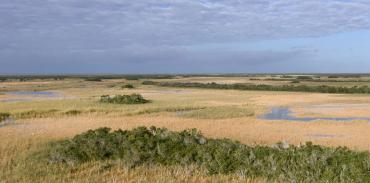
Are bureaucrats at the U.S. Army Corps of Engineers looking for "opportunities to walk away from 18 years of congressional commitment to restore America’s Everglades?"
That's what it looked like to South Florida Water Management District Board Chairman Federico E. Fernandez and Executive Director Ernie Marks.
On May 30 Assistant Secretary of the Army R.D. James had written to Marks to let him know SFWMD's southern reservoir plan had passed the Army's muster. "In accordance with Section 203 of WRDA 1986, I am responsible for determining whether the report, and the process under which the report was developed, complies with federal laws and regulations applicable to feasibility studies of water resources development projects," James wrote.
"Based on the recommendations of my staff, I have determined that the project identified in the Integrated Feasibility Study and DRAFT Environmental Impact Statement is feasible and fully recognize the importance of this project to the restoration of the Everglades system."
But then, along came staff at the U.S. Army Corps of Engineers' (USACE) Washington headquarters, "passing over years of rock-solid science," to question the Everglades' need for more water.
"At present, it is unclear how Sec. 203 or its Addendum makes a scientifically justified case that the additional flows of water diverted from the Northern Estuaries are essential to the restoration of the Central Everglades," wrote the USACE staff (see page 75). "The opinion at Addendum page 35 that such water is 'essential' to Everglades restoration because that water is 'critically important to the health of the Everglades' is conclusory; it does not provide a technical basis by which to judge the reasonableness for adopting such a conclusion."
Yet, this has been where Everglades restoration has been going for the last 18 years. The EAA Storage Reservoir was an original component of the Comprehensive Everglades Restoration Plan as approved by the U.S. Congress in 2000.
Matt Morrison told Sunshine State News on Tuesday the $3.5 billion remaining cost of CERP pays for two-thirds of the water the Everglades needs, and now will include the $1.4 billion, to provide the final one-third from the EAA Reservoir.
On Friday Fernandez and Marks penned a stinging letter to R.D. James, assistant secretary of the Army, Civil Works after U.S. Army Corps of Engineers staff saying comments from the Corps' staff suggest the Corps doesn’t want to pay their cost share and that the water currently bombing the St. Lucie and Caloosahatchee estuaries would not be better used going into the Everglades.
"Water wasted to tide in the Northern Estuaries is THE water needed to restore the Quantity, Quality, Timing and Distribution of water within the Everglades system," the two reminded James in their letter.
"Moreover, SFWMD stands behind the science it used to conclude that the plan achieves water quality standards under the Clean Water Act (CWA). Because USACE staff is intent on continued study, we strongly urge you to expedite the National Environmental Policy Act and U.S. Environmental Protection Agency (US EPA) review."
To recap on what this is all about: Senate Bill 10, approved by the Florida Legislature and signed into law by Gov. Rick Scott in 2017, provided funding and direction to the SFWMD to expedite planning, design and construction of the EAA Storage Reservoir.
The goals of the reservoir project are to reduce damaging discharges from Lake Okeechobee to the northern estuaries by providing additional water storage, treatment and conveyance south to the Everglades, where the water is needed.
The SFWMD conducted a study to achieve these goals and address the need for additional water storage, treatment and conveyance south of Lake Okeechobee.
The study was conducted under Section 203 of the Water Resources Development Act of 1986, as amended. It allows non-federal entities like the SFWMD to develop feasibility studies. These proposed water resources development projects are then submitted to the Assistant Secretary of the Army (ASA).
"This is a very big thing," said Matt Morrison, the District's head of federal policy and coordination, who led the design and planning for the project. "Section 203 has been around for 32 years, yet Florida’s plan to direct clean water south to the Everglades is the first plan in the nation to actually be developed by a non-federal sponsor and win the ASA's favorable Section 203 feasibility determination."
But, he said, "If the Corps is backing away from an 18-year commitment to restore the Everglades, you can't overestimate the importance of such an act. The Everglades doesn't belong just to Florida, it's a national interest, with a national park."
The next step is for the Office of Management and Budget to conduct its review, and then, hopefully, forward the plans to Congress for inclusion in the upcoming Water Resources and Development Act by Oct. 1.
“All I can say at this point is, I'm cautiously optimistic," Morrison said. "We had so much support from the Corps staffs in Jacksonville and Atlanta. It's been frustrating and disappointing seeing what the Washington staff have to say."
Members of the Florida Congressional Delegation were still working on their response late Tuesday.
Reach Nancy Smith at nsmith@sunshinestatenews.com or at 228-282-2423. Twitter: @NancyLBSmith
READ MORE FROM SUNSHINE STATE NEWS
Sen. Bradley Has It Right: Move Ahead with District Reservoir Plans


